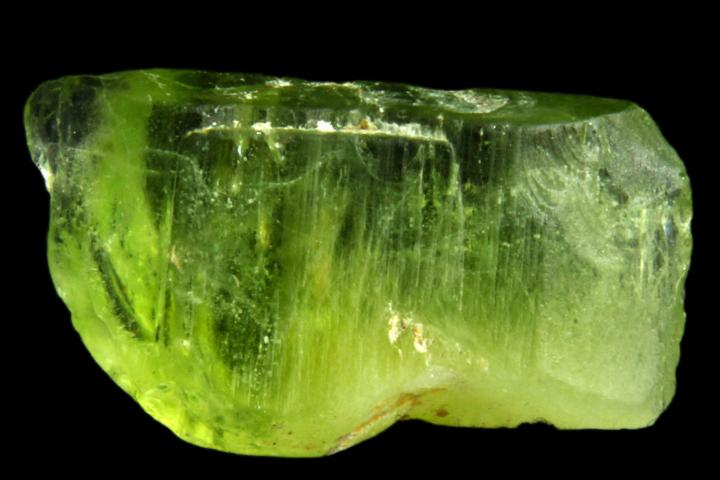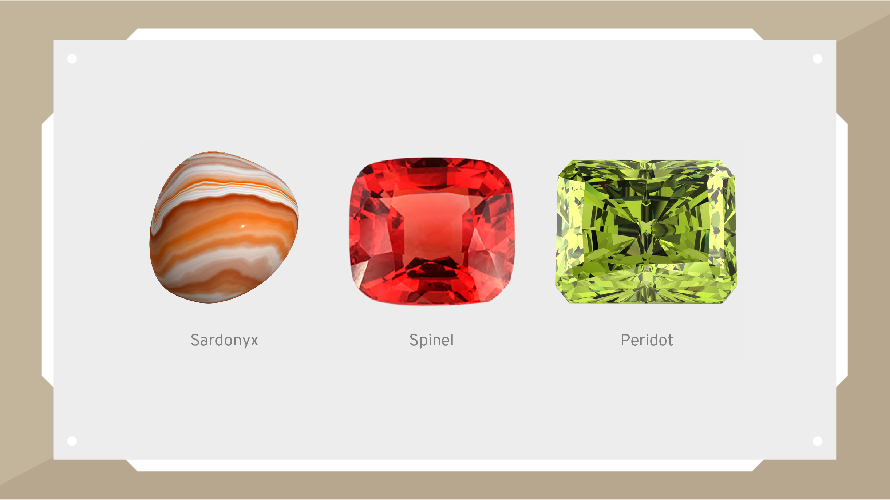Such beautiful stones emerge from our Earth, and the verdant green August birthstone—peridot— is said to have the healing powers of nature. But August babies get to choose from three birthstones (peridot, sardonyx, and spinel)! Learn more.
Peridot’s Color
Best known for its lime-green color, the peridot receives its envious coloration from the composition of the mineral olivine. This is unlike many other gems whose colors come from impurities. It’s one of the few gemstones that comes in a single color, too. However, peridot can vary in shade from yellow-green to olive to brown-green.
Peridots are made up of a chemical composition that includes iron and magnesium, and the color depends on the amount and type of iron that is present. Ferrous iron (FeO) creates the green color, while ferric iron (Fe2O3) is responsible for the more yellow shades.
Peridot is both a day stone and a night stone, keeping its shining color even under artificial lighting. For this reason, it is sometimes called “Evening Emerald”.
Peridot Meanings, Symbolism, and Folklore
- It is unclear where the name “peridot” originated. Some believe it is derived from the Arabic faridat, meaning “gem,” or from the Greek word peridona, which means “give in abundance.”
- Given its resemblance to the color of money, peridot has often been associated with prosperity and good fortune.
- According to Hawaiian religious beliefs, peridots are said to be the tears of Pele, the goddess of fire and volcanoes and the creator of the Hawaiian Islands.
- Ancient Egyptians called the peridot the “gem of the Sun,” as they believed it protected those who wore it from the terrors of the night.
- Egyptian priests believed it held the power of nature, using goblets encrusted with peridots to communicate with nature gods.
- Peridots were once used to help with respiratory ailments, insomnia, and bleeding. They were also thought to improve memory and ease labor and delivery.
- For years, peridot beads and talismans were believed to offer protection and promote love, happiness, and wealth.

Where do Peridots Come From?
Peridot is the name given to gem-quality olivine, a mineral that forms deep in Earth’s mantle and is brought to the surface by volcanic activity. It is often found in volcanic rocks known as basalts. Rarely it can be found inside meteorites, with some crystals dating back more than 4 billion years.
Peridots were first recorded on Topazios, a small island in the Red Sea now known as St. John’s Island or Zabargad Island. Pliny the Elder, an ancient Roman naturalist, is among those who have written about the island and its gemstones.
In the 1990s, deposits were discovered in Pakistan, producing some of the finest peridots ever found.
Today, the San Carlos Apache Reservation in southeastern Arizona is responsible for the majority of the world’s peridot supply. The gem can also be found in China, Myanmar, Vietnam, Africa, and Pakistan.
Peridots in History
- Peridots have a rich history dating back to ancient Egyptian times when deposits were found on a small volcanic island in the Red Sea.
- For many years, the gem was often confused for emeralds. In fact, it is thought that a portion of Cleopatra’s emerald collection was, in fact, made up of peridots. And it is not the only time the gem was confused for an emerald: the 200-carat stones that made up the Three Holy Kings shrine in Germany’s Cologne Cathedral were also found to be peridots!
- In the Middle Ages, peridots were worn to provide foresight and inspiration. Romans used the stones to protect against enchantment.
- In 2005, peridot was found in comet dust upon the return of the Stardust space probe.
- In addition to being the birthstone for August, peridot is also the gemstone given for a 16th wedding anniversary.
- The largest known peridot, weighing in at 310 carats, is part of the collection at the Smithsonian National Museum of Natural History in Washington, D.C.
Peridot in Jewelry
Peridots are common in jewelry—from necklaces and rings to earrings and bracelets.
With a Mohs Hardness rating of 6.5 to 7.0, it is softer than many gems. Those wearing it daily should use caution to avoid damaging the gem. When storing, keep gems away from harder stones and jewelry to prevent scratching.
To clean peridot, use a soft-bristle brush with a mixture of mild dish soap and warm water.

Other Birthstones for August
The peridot has become the gem most often associated with those born in the final full month of summer, but there are two other birthstones tied to August.
- A second birthstone is the sardonyx, which is has white bands of onyx and the reddish layers of sard that creates a reddish-white banded appearance. It’s long been viewed as a stone of protection. Ancient Greeks and Romans wore sardonyx talismans to the battlefields to harness courage, bravery, and protection.
- Even more recently, spinel was added to the list of August birthstones. This rich red stone can look identical to a ruby. In fact, for centuries, spinel masqueraded as ruby in Europe’s crown jewels. The Imperial State Crown of England, which was once thought to hold an enormous ruby, actually holds an enormous red spinel.
Sardonyx
- The sardonyx is a combination of two types of chalcedony, sard and onyx. The gem is made up of alternating layers of sard and onyx, creating a yellowish-red to reddish-brown zebra-striped gem with bands of black or white. Just imagine the planet Jupiter as a gemstone!
- In ancient times, Greeks and Romans wore sardonyx into battle. It would be engraved with images of gods because they believed the stone could harness bravery and provide courage and protection.
- Sardonyx was also thought to invoke happiness and clear communication. Others believed a sardonyx gemstone in each corner of your home would provide protection against evil.
- Historically, it has been used in seals and signet rings, as wax would not stick to the sardonyx.
- The gem is found around the world, including in India, Brazil, Germany, Uruguay, and the United States.
Spinel
- Many have labeled the spinel as one of the most under-appreciated gems. For centuries, the gem was often mistaken for ruby and pink sapphire. In fact, some of history’s most famous rubies have actually been spinels, including the Black Prince’s Ruby and the Timur Ruby, both part of the Crown Jewels of England.
- It was not until the 18th century that the spinel was differentiated from the ruby due to chemical differences.
- Along with other red gems, the spinel was believed to be a remedy for blood disorders and inflammatory diseases. It has also been associated with joy and feelings of positivity and thought to inspire relaxation.
- In addition to its well-known red appearance, the spinel comes in a variety of colors—cobalt blue, pink (bright and pale), purple, orange, black, yellow, and brown.
- The spinel has recognizable features that set it apart: its octahedral crystal makeup and single refraction.
- In Burma, the saying nat thwe, meaning “polished by the spirits,” is used to describe the gem.
- Spinels are found all over the world, including Afghanistan, Nepal, Sri Lanka, Tanzania, and the United States.
- Added to the list of August birthstones in 2016, the spinel is also given as a 22nd wedding anniversary present.
Learn More











